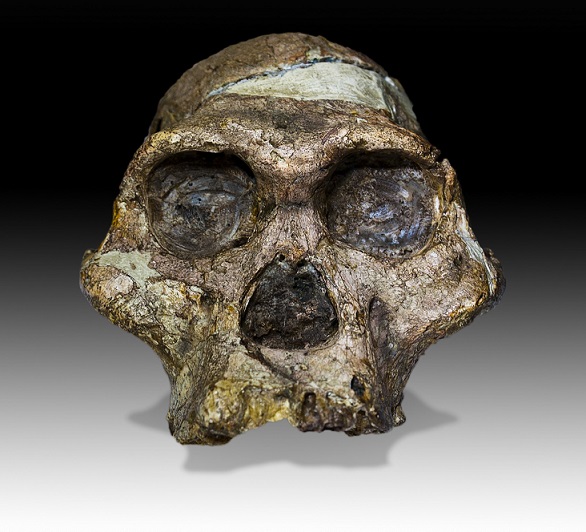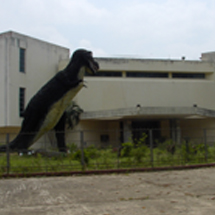সর্ব-শেষ হাল-নাগাদ: ১৫ জুন ২০২১
অস্ট্রা লেপিথিকাস
প্রথম অস্ট্রেলোপিথেকাস নমুনা, প্রকারের নমুনাটি ১৯২৪ সালে দক্ষিণ আফ্রিকার তাউং-এ শ্রমিকদের দ্বারা একটি চুনের খোঁড়ায় আবিষ্কার হয়েছিল। এই নমুনাটি অস্ট্রেলিয়ান অ্যানাটমিস্ট রায়মন্ড ডার্টের দ্বারা অধ্যয়ন করা হয়েছিল, যিনি তখন জোহানেসবার্গের উইটওয়টারস্র্যান্ড বিশ্ববিদ্যালয়ে কর্মরত ছিলেন। জীবাশ্মের খুলি তিন বছর বয়সী বাইপিডাল প্রাইমেটের ছিল যেটির নাম তিনি অস্ট্রেলোপিথেকাস আফ্রিকানাস রেখেছিলেন। প্রথম প্রতিবেদন ১৯২৫ সালের ফেব্রুয়ারিতে প্রকৃতিতে প্রকাশিত হয়েছিল। প্রাথমিকভাবে নৃবিজ্ঞানীরা এই আবিষ্কারটিকে বোকা ছাড়া কিছু ছিল না বলে ধারণা করা বেশিরভাগ ক্ষেত্রেই বৈরী ছিল, যদিও ১৯৪০ এর দশকের শেষের দিকে এটি পরিবর্তিত হয়েছিল। ১৯৫০ সালে, বিবর্তনীয় জীববিজ্ঞানী আর্নস্ট ওয়াল্টার মায়ার বলেছিলেন যে সমস্ত দ্বিপদী এপসকে হোমো বংশের মধ্যে শ্রেণীবদ্ধ করা উচিত এবং অস্ট্রেলোপিথেকাসের নাম পরিবর্তন করে হোমো ট্রান্সভ্যালেনসিস হিসাবে নেওয়া উচিত। পূর্ব আফ্রিকার প্রথম অস্ট্রোলোপিথেসিন জীবাশ্ম আবিষ্কৃত হয়েছিল একটি এ। বোইসেই খুলি যা মেরি লিকি ১৯৫৯ সালে তানজানিয়ার ওল্ডুভাই গর্জে খনন করেছিলেন। সেই থেকে, লেকি পরিবার অস্ট্রোলোপিথেসিনগুলির পাশাপাশি হোমো হাবিলিস এবং হোমো ইরেক্টাসের জন্য আরও প্রমাণ উন্মোচন করে ঘাটটি খনন করে চলেছে। অস্ট্রেলোপিথেকাসকে মানব পরিবারের গাছের সদস্য হিসাবে ব্যাপকভাবে গ্রহণ করতে বৈজ্ঞানিক সম্প্রদায়টি আরও ২০ বছর সময় নিয়েছে।

The first Australopithecus specimen, the type specimen, was discovered in 1924 in a lime quarry by workers at Taung, South Africa. The specimen was studied by the Australian anatomist Raymond Dart, who was then working at the University of the Witwatersrand in Johannesburg. The fossil skull was from a three-year-old bipedal primate that he named Australopithecus africanus. The first report was published in Nature in February 1925. Initially, anthropologists were largely hostile to the idea that these discoveries were anything but apes, though this changed during the late 1940s. In 1950, evolutionary biologist Ernst Walter Mayr said that all bipedal apes should be classified into the genus Homo, and considered renaming Australopithecus to Homo transvaalensis. The first australopithecine fossil discovered in eastern Africa was an A. boisei skull excavated by Mary Leakey in 1959 in Olduvai Gorge, Tanzania. Since then, the Leakey family has continued to excavate the gorge, uncovering further evidence for australopithecines, as well as for Homo habilis and Homo erectus. The scientific community took 20 more years to widely accept Australopithecus as a member of the human family tree.
সর্বশেষ খবর
পবিত্র ঈদ-উল-ফিতর, ২০২৫ উপলক্ষে আগামী ২৭ মার্চ ২০২৫ থেকে ৪ এপ্রিল ২০২৫ তারিখ পর্যন্ত জাতীয় বিজ্ঞান ও প্রযুক্তি জাদুঘরের গ্যালারী প্রদর্শনী কার্যক্রম বন্ধ থাকবে।
Array
(
[id] => 7940452d-2f6d-4e42-8f87-8afb3227ed08
[version] => 63
[active] => 1
[publish] => 1
[created] => 2015-01-25 15:58:17
[lastmodified] => 2024-11-03 13:26:54
[createdby] => 136
[lastmodifiedby] => 2598
[domain_id] => 6414
[office_id] =>
[menu_id] =>
[title_bn] => মহাপরিচালক
[title_en] => Director General
[body_bn] =>
[body_en] =>
[userpermissionsids] =>
[uploadpath] => e9005938-c62a-4cda-bdf2-fb21556182fc
[userip] => 127.0.0.1
[useragent] => Mozilla/5.0 (Windows NT 10.0; Win64; x64) AppleWebKit/537.36 (KHTML, like Gecko) Chrome/130.0.0.0 Safari/537.36
[usergeo] =>
[is_right_side_bar] => 1
[office_head_photo] => Array
(
[0] => Array
(
[name] => 2024-11-03-07-22-6b2a72f3355ff271bf2bf600fddeeab8.jpg
[caption_bn] => মহাপরিচালক
[caption_en] => Director General
[link] =>
)
)
[office_head_description] => মহাপরিচালক
[office_head_des_bn] => মুনীরা সুলতানা এনডিসি
মুনীরা সুলতানা এনডিসি, অনানুষ্ঠানিক বিজ্ঞান শিক্ষা কার্যক্রমের মাধ্যমে একটি বিজ্ঞানমনস্ক জাতি গঠনের লক্ষে ৩১ অক্টোবর, ২০২৪খ্রিঃ তারিখে জাতীয় বিজ্ঞান ও প্রযুক্তি জাদুঘরের মহাপরিচালক হিসেবে দায়িত্ব গ্রহণ করেন।
তিনি ১৯৯৩ সালে বাংলাদেশ সিভিল সার্ভিস প্রশাসন ক্যাডারে যোগদানের মধ্য দিয়ে কর্মজীবন শুরু করেন। তিনি বেশিরভাগ সময় বিভিন্ন মন্ত্রণালয় ও অধিদপ্তরে এবং মাঠ প্রশাসনে দায়িত্ব পালন করেন। ঢাকা বিশ্ববিদ্যালয় থেকে উদ্ভিদবিদ্যা বিভাগ থেকে তিনি স্নাতকোত্তর ডিগ্রি অর্জন করেন। চাকরিতে কর্মরত অবস্থায় তিনি নর্দান ইউনিভার্সিটি, ঢাকা থেকে গভর্নেন্স স্টাডিজ বিষয়ে দ্বিতীয় স্নাতকোত্তর ডিগ্রি অর্জন করেন। তিনি ২০১৮ সালে ন্যাশনাল ডিফেন্স কলেজ থেকে ন্যাশনাল ডিফেন্স কোর্স সাফল্যের সাথে সম্পন্ন করেন।
চাকুরিরত অবস্থায় তিনি দেশে এবং বিদেশে বিভিন্ন পেশাগত প্রশিক্ষণ কোর্স সাফল্যের সাথে সম্পন্ন করেন। একটি বিজ্ঞানমনস্ক জাতি গঠনে এবং সারা দেশে বিজ্ঞান ও প্রযুক্তির সুফল ছড়িয়ে দিতে তিনি নিরলস কাজ করে যাচ্ছেন।
[office_head_des_en] => Munira Sultana ndc
Munira Sultana ndc, took charge as Director General of National Museum of Science and Technology on October 31, 2024 with the aim of building a science minded nation through informal science education programs.
She started her carrier in the Bangladesh Civil Service administration cadre in 1993. She served mostly in field administration and different ministries and directorate. She earned her degree of M.Sc. in Botany from the University of Dhaka. While in service, she earned a second Masters degree in Governance Studies from the Northern University, Dhaka. She completed the National Defense Course successfully in 2018 from National Defense College.
She acquired various professional training courses during her service period in home and abroad and keenly interested in building a science minded nation and spread the blessings of Science and Technology across the country.
[designation] =>
[designation_new_bn] => মহাপরিচালক
[designation_new_en] => Director General
[weight] => 0
)
=======================
কেন্দ্রীয় ই-সেবা
পথ নির্দেশিকা

হটলাইন

সামাজিক যোগাযোগ

জরুরি হেল্পলাইন নম্বর




.jpg)













